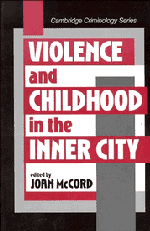Book contents
- Frontmatter
- Contents
- List of Contributors
- Preface
- 1 Violence and the Inner-City Street Code
- 2 The Embeddedness of Child and Adolescent Development
- 3 Placing American Urban Violence in Context
- 4 Neuropsychology, Antisocial Behavior, and Neighborhood Context
- 5 Psychological Mediators of Violence in Urban Youth
- 6 Understanding and Preventing Child Abuse in Urban Settings
- 7 Intervening to Prevent Childhood Aggression in the Inner City
- Name Index
- Subject Index
2 - The Embeddedness of Child and Adolescent Development
A Community-Level Perspective on Urban Violence
Published online by Cambridge University Press: 01 June 2011
- Frontmatter
- Contents
- List of Contributors
- Preface
- 1 Violence and the Inner-City Street Code
- 2 The Embeddedness of Child and Adolescent Development
- 3 Placing American Urban Violence in Context
- 4 Neuropsychology, Antisocial Behavior, and Neighborhood Context
- 5 Psychological Mediators of Violence in Urban Youth
- 6 Understanding and Preventing Child Abuse in Urban Settings
- 7 Intervening to Prevent Childhood Aggression in the Inner City
- Name Index
- Subject Index
Summary
Approaches to Understanding Violence
Two strategies dominate the study of crime and violence. The macrosocial or community level of explanation asks what it is about the nature of communities that yields differential rates of crime and its control (Short, 1985). Hence the goal of macrosocial research is not to explain individual involvement in criminal behavior but to identify characteristics of communities, cities, or even societies that lead to high rates of crime. Following the lead of Shaw and McKay's (1942) seminal research in Chicago earlier this century, a host of studies have examined the community-level relationship between crime rates and factors such as low economic status, ethnic heterogeneity, residential mobility, population density, and divorce rates (for detailed reviews, see Byrne & Sampson, 1986; Bursik & Grasmick, 1993; Sampson & Lauritsen, 1994). In this research tradition, the ecological fallacy of inferring individual-level relations based on aggregate data is not at issue because the unit of explanation and analysis is the community itself.
By contrast, the more common research strategy seeks to distinguish delinquents from nondelinquents. Influenced by the hegemony of survey research in the social sciences since the 1960s (especially the predominance of self-report surveys), researchers on delinquency and violence have focused primarily on the individual level of analysis. For example, a large body of research has examined how factors such as broken homes, parental supervision, erratic discipline, and school attachment are related to an adolescent's involvement in delinquency (for overviews, see Rutter & Giller, 1983; Loeber & Stouthamer-Loeber, 1986; Gottfredson & Hirschi, 1990).
- Type
- Chapter
- Information
- Violence and Childhood in the Inner City , pp. 31 - 77Publisher: Cambridge University PressPrint publication year: 1997
- 85
- Cited by

